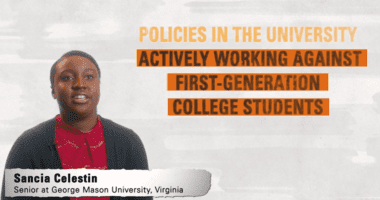The ASPIRE ACT: Improving Student Outcomes and Equity in Higher Education
Colleges and universities are under increasing pressure to demonstrate their value to an increasingly skeptical public. Low graduation rates, rising college costs, and huge debt loads leave many Americans wondering if our higher education system is working as it should. Policymakers are under pressure to respond to this scrutiny, searching for ways to hold campuses responsible for ensuring that students get what they came for, and that a college education doesn’t come at a cost that is too burdensome for them or for society.
At Ed Trust, we believe there needs to be institutional responsibility for college student outcomes. But those expectations should be coupled with resources and support to improve. And there needs to be an explicit focus on equity, including holding wealthy institutions responsible for enrolling and supporting low-income students and students of color. Currently, the U.S. higher education policy landscape does none of that.
Enter the Access, Success, and Persistence In Reshaping Education Act (ASPIRE): Introduced this week by Senators Coons (D-DE) and Isakson (R-GA), the bill seeks to better align the over $70 billion that the federal government invests in higher education with efforts to improve student outcomes and equity. It would incentivize four-year institutions to expand access to higher education for low-income students and increase graduation rates for all students. Low-income students and students of color — who often are less likely to graduate, more likely to take on more debt, and struggle to repay their student loans than their higher income and White peers — stand to benefit greatly.
The ASPIRE Act takes a Robin Hood approach: Wealthy institutions that enroll too few low-income students will face a financial penalty. Those resources would then be devoted to campuses serving large proportions of low-income students that are making active efforts to improve completion rates. Campuses that receive the additional resources would also be subject to higher access and completion standards. The bill also rewards institutions that are already on the right track when it comes to access and completion by making additional competitive funding available for completion efforts, with priority for minority-serving institutions. Finally, it offers institutions with high access and completion rates the chance to apply for non-financial rewards, such as bonus points in federal competitive grants or a reduced regulatory burden.
This is not the first policy to try to address access and completion issues. But the ASPIRE Act would go further than any other existing federal policy to align funding with outcomes. And that’s a good thing. But as with other attempts to make higher education funding more aligned with student outcomes, there’s the potential for adverse consequences. Performance or outcomes-based funding, for example, has led to campuses limiting access and opportunity, especially for groups with the lowest completion rates (i.e., low-income students and students of color).
As with any policy, then, we must examine the impact the ASPIRE Act would have on access and opportunity for low-income students and students of color. Based on how the bill defines “performance,” our analysis determined that Black students are overrepresented at the campuses that will be among the bottom performers on graduation. And campuses such as for-profit colleges and historically Black colleges and universities (HBCUs) that serve large proportions of low-income students and students of color are overrepresented among the institutions that will be among the bottom performers on graduation.
However, these HBCUs would also be eligible for more resources for completion focused initiatives, which is critical. And the bill will push schools with higher completion rates to increase access for low-income students, and along with it, increase the likelihood that more low-income students graduate from college.
The ASPIRE Act is not perfect. There are nuances to the bill that warrant further discussion and debate. Still, as work on reauthorizing the Higher Education Act begins in Congress, the ASPIRE Act provides an example of how to incorporate an equity focus into a policy approach that holds campuses responsible for student outcomes for all types of students, regardless of race/ethnicity or family income.











